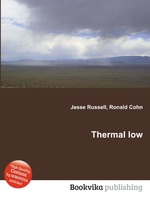Thermal low
Jesse Russell Ronald Cohn
бумажная книга
High Quality Content by WIKIPEDIA articles! Thermal lows, or heat lows, are non-frontal low-pressure areas that occur over the continents in the subtropics such as near the Sonoran Desert, the Mexican plateau, Sahara, South America over northwest Argentina, Australia, the Iberian peninsula, and Tibetan plateau during the warm season as the result of intense heating when compared to their surrounding environments. Over land, intense, rapid solar heating of the lower layers of air creates hot air, which is less dense than surrounding cooler air. This, combined with the rising of the hot air, results in the formation of a low pressure area. Elevated areas can enhance the strength of the thermal low as they warm more quickly than the atmosphere which surrounds them at the same altitude. Over the water, thermal lows form during the winter when the air overlying the water bodies is colder than the warmer water. Thermal lows tend to have weak circulations, and can extend to 3,100 metres (10,200 ft) in height. Thermal lows over the western and southern portions of North America, northern Africa, and southeast Asia are strong enough to lead to summer monsoon conditions. Development of thermal lows inland of the coastline lead to the development of sea breezes. Sea breezes combined with rugged topography near the coast can encourage poor air quality.


